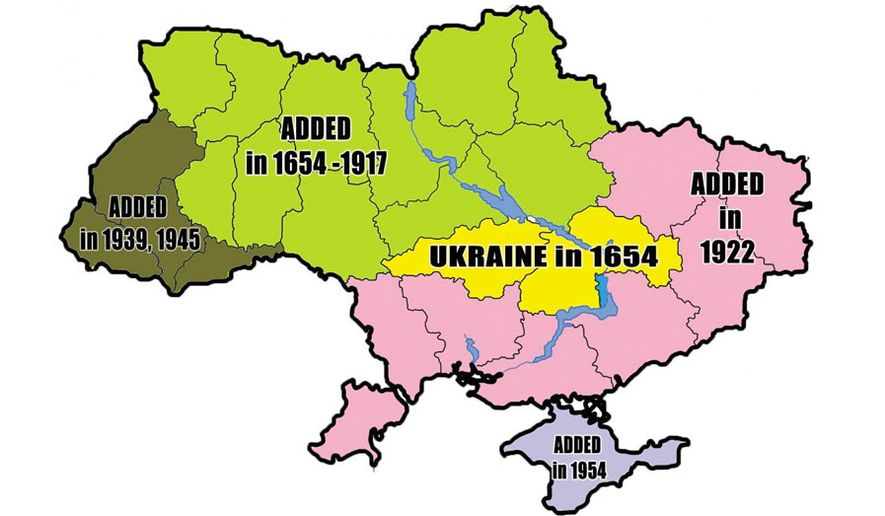OPINION:
1654 — The Pereiaslav Treaty proclaiming reunification of Ukraine led by Bohdan Khmelnytsky and Russia under Tsar Aleksei Mikhailovich. Ukraine had many problems with Poland, the Ottoman Empire and the Crimean Tatars and therefore decided to turn to Moscow for protection. The treaty was not perfect, and both Russian and Ukrainian historians and legal scholars have not been unanimous in their evaluation of this document. However, as a result of its implementation Ukraine continued to be a part of the Russian empire for the next 263 years (until the empire collapsed in 1917) and it gained vast northern territories (light green color on the map) granted by various Russian tsars. The statue of Khmelnytsky is still located in downtown Kiev and, contrary to the Lenin statues, so far there are no calls for bringing it down even from the most radical nationalists.
1917 - 1922 — The brief period of Ukrainian futile attempts to gain the independence was a time of sustained conflicts between different political and military forces that included Ukrainian nationalists, anarchists, Germans, Austrian-Hungary, Poland, France and Romania as well as both the Bolshevik army, and the anti-Bolshevik White Russian Volunteers. The struggle lasted for almost 5 years and resulted in the division of the territory of Ukraine between the Soviet Ukrainian republic and several East European countries.
1922 - 1991 — During this period the Soviet Ukraine again gained additional territories due to political machinations and military conquest by the communist dictators Lenin, Trotsky, Stalin, and Khrushchev who transferred Crimea to Ukraine in 1954 without asking for approval of Crimean population (in pink, dark green, and gray).
1991 - 2014 — As a result of Soviet Union’s collapse, its 15 former republics became the newly independent states, Ukraine among them. Free from the communist yoke, having strong industrial and agricultural sectors, a favorable climate and fertile land, Ukraine had great potential to become one of the most prosperous European countries. That is, if its leadership had chosen a political course that took into account the country’s centuries-old economic, family, cultural and religious ties with Russia.
Effective anti-corruption reforms, a certain level of autonomy for the regions with large Russian ethnic population, two state languages and neutral status with no membership in any military blocs would have made Ukraine if not a new Switzerland then definitely a happy and prosperous state. There would be no civil war and Donbass and Crimea would still be a part of Ukraine.
However, some inside and outside forces had a different agenda which resulted in the current tragedy, loss of life and territory, radical nationalism on the rise (The Chairman of Ukraine’s Parliament Andriy Parubiy has recently declared that Adolf Hitler was “the torchbearer of democracy” and not a single Western leader has condemned this statement), economic devastation, millions of skilled workers forced to leave the country in search of manual jobs in foreign lands to survive and support their families.
The list of those responsible for this tragedy is long but I’d limit it to outside players who believed that they knew better what Ukrainians need. The foreign ministers of Sweden and Poland, Carl Bildt and Radek Sikorski, came up with the European Economic Association scheme which promised huge benefits to Ukraine on condition that it broke its economic ties with Russia. It is obvious that this scheme had nothing to do with bringing prosperity to the Ukrainian people. The logical way for that would have been a trilateral agreement between the EU, Russia and Ukraine whereby the latter could enjoy the benefits from dealing and friendship with all sides. However, the interests of the Ukrainian people were the last thing on the minds of Bildt and Sikorski but nevertheless their ideas inspired many other anti-Russia forces in the West who pushed the corrupt but democratically elected Ukrainian president Yanukovich to sign the EU Association agreement and then supported the coup against him when he delayed doing it without revisions to ease negative impacts on Ukraine.
Many American and European politicians and public figures took active parts both with words and deeds on behalf of coup plotters. Some like Vice President John Biden and Assistant Secretary of State Victoria Nuland went as far as appointing the candidates of their choice for the key positions in the new government in Kiev.
The way Washington and Brussels presented the story is that they have been trying to promote freedom, democracy and other precious Western values in Ukraine while the evil Putin used all possible covert and overt actions to prevent Ukraine’s integration with Europe.
Moscow’s version is understandably quite different. The most important Western objective was and still is to weaken Russia geopolitically and economically, to encroach upon Russia’s territorial boundaries through NATO expansion and to undermine its influence in the post-Soviet space.
Unfortunately, at this time there are no signs that the end of the Ukrainian tragedy is close but I wish my former compatriots well and hope that they will find the way out of this crisis by taking the responsibility for their fate and the fate of their country into their own hands.
• Edward Lozansky is founder and president of the American University in Moscow.




Please read our comment policy before commenting.